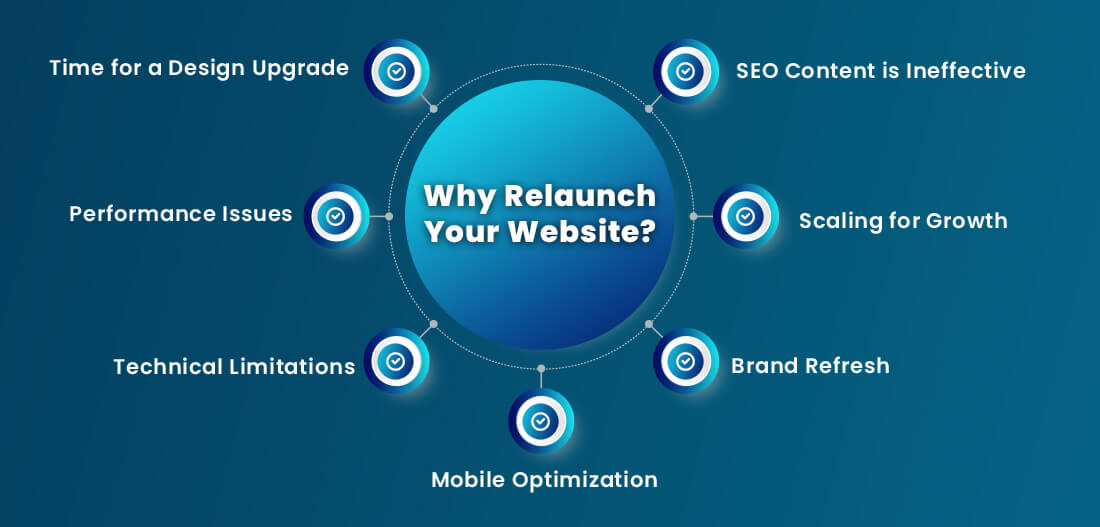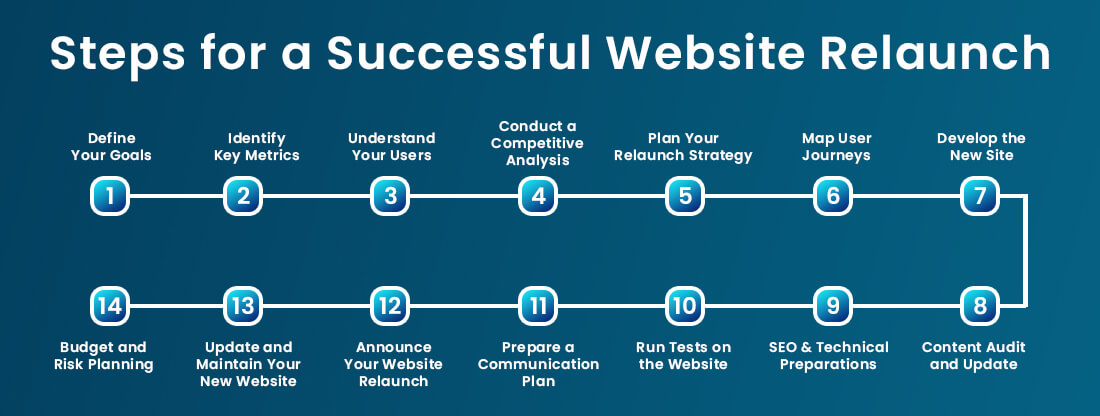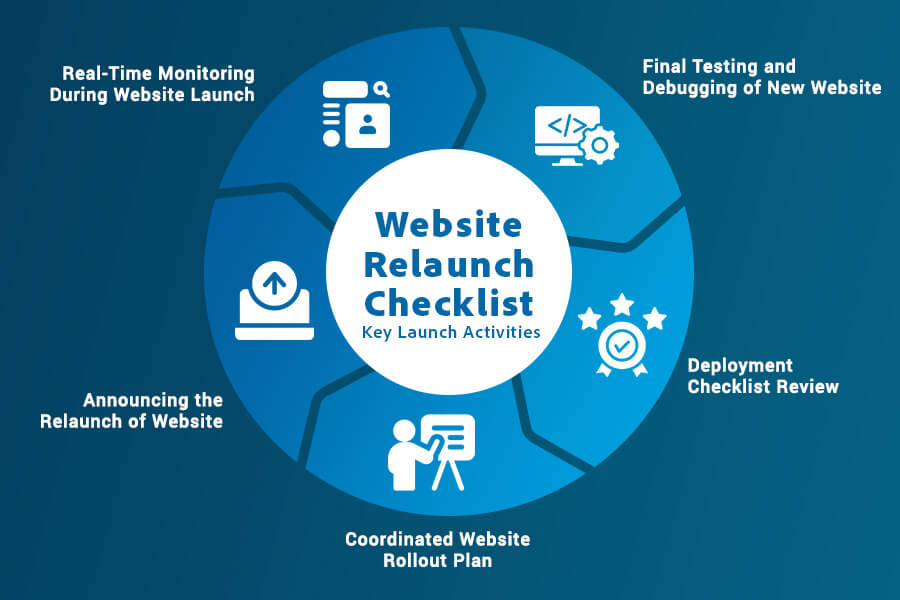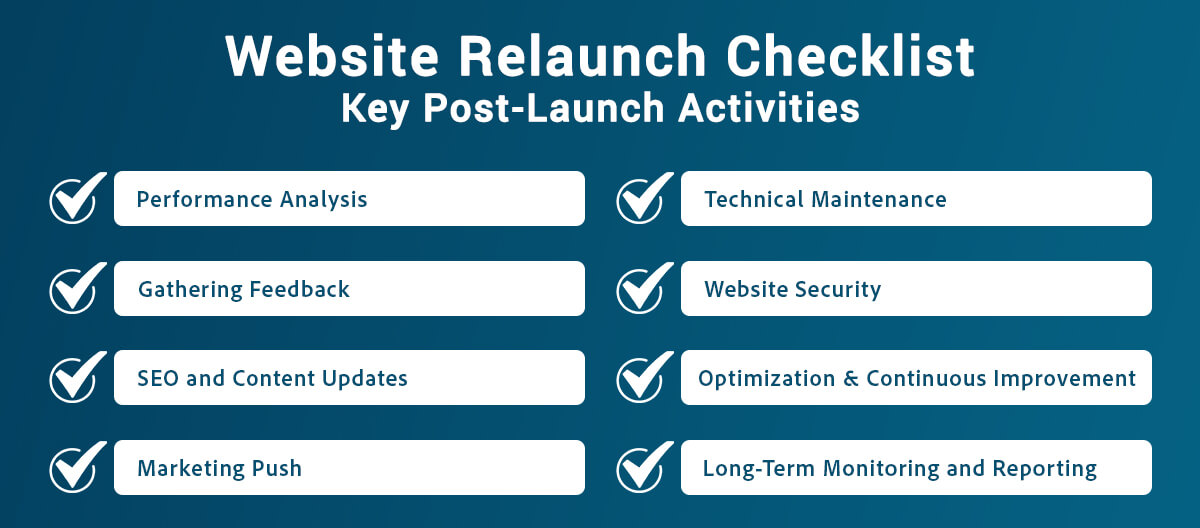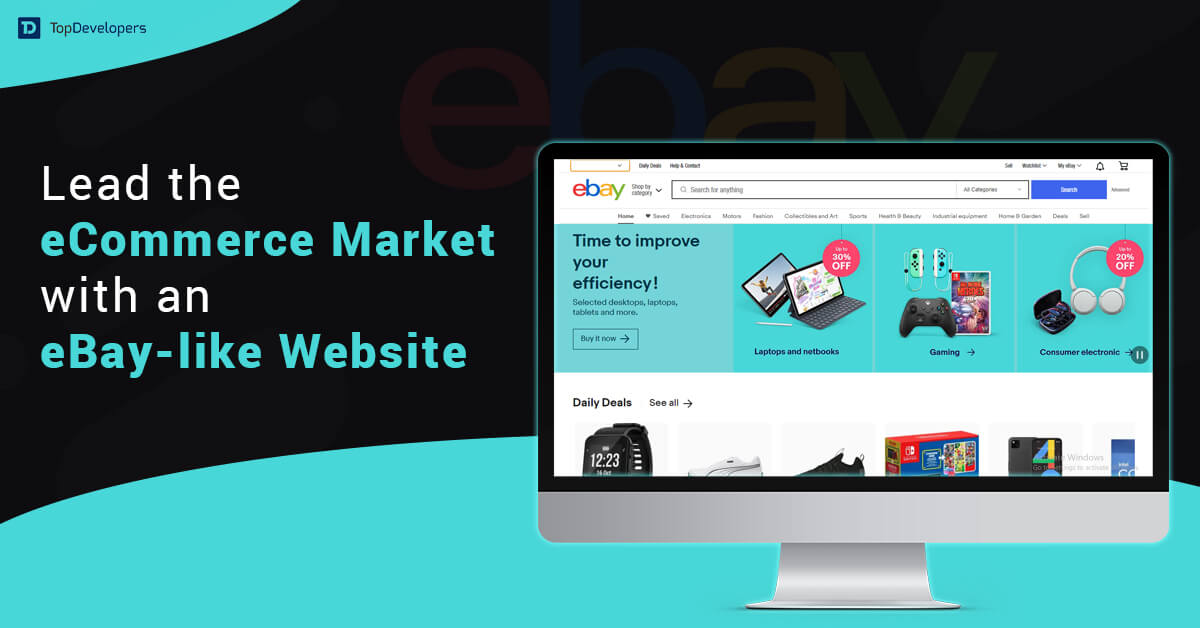
A website relaunch isn’t just an update; it’s a critical strategy for businesses to maintain a competitive edge in today’s fast-evolving digital world. Your website often serves as the first point of contact between your brand and potential customers, making its performance and design crucial to your success.
Recent data underscores the importance of a well-executed website relaunch. According to a 2024 report by Statista, online conversion rates of e-commerce sites were the highest in the beauty and makeup sector, at 2.3 percent in the third quarter of 2024.
Furthermore, According to a 2025 report by VWO, 61.5% of website redesign projects are initiated due to poor user experience (UX), highlighting the critical role of UX in retaining visitors and driving engagement. Additionally, 80.8% of people begin a website redesign project because of low conversion rates, emphasizing the need for a strategic approach to website relaunches to enhance business performance.
These statistics highlight that a thoughtfully planned website relaunch can significantly enhance user experience and drive business growth.
This comprehensive guide will walk you through the essential aspects of a successful website relaunch. From understanding the reasons behind a relaunch to meticulous planning and execution, we’ll cover each step to ensure your website not only meets but exceeds modern standards.
Let’s embark on this journey to revitalize your online presence and achieve your business objectives.
Table of Contents
- Why Relaunch Your Website?
- Planning Your Website Relaunch
- Define Your Goals
- Identify Key Metrics
- Understand Your Users
- Conduct a Competitive Analysis
- Plan Your Relaunch Strategy
- Map User Journeys
- Develop the New Site
- Content Audit and Update
- SEO and Technical Preparations
- Run Tests on the Website
- Prepare a Communication Plan
- Announce Your Website Relaunch
- Update and Maintain Your New Website
- Budget and Risk Planning
- Strategic Foundations for a Successful Website Relaunch
- Launch Activities for New Website Relaunch
- Post-Launch Activities for New Website Relaunch
- Conclusion
Why Relaunch Your Website?
A website relaunch isn’t just about keeping up with digital trends; it’s a strategic move to address evolving customer expectations, tackle technical limitations, and create a stronger foundation for future growth. With increasing competition and rapidly changing technologies, your website must be more than just visually appealing—it needs to deliver seamless functionality, engaging content, and optimized performance.
Time for a Design Upgrade
Your website is often the first impression customers have of your brand. If its design looks outdated, users might perceive your business as stagnant or irrelevant. A modern, sleek, and user-friendly design not only enhances credibility but also keeps visitors engaged, improving overall user experience and conversion rates. An outdated design can no longer compete in a digital landscape where aesthetics and functionality go hand in hand.
Performance Issues
A slow-loading website doesn’t just frustrate users; it directly impacts your bottom line. Studies show that 53% of mobile users abandon a site that takes more than three seconds to load. Performance issues such as lagging pages, server downtime, or unoptimized media files can deter potential customers. A website relaunch allows you to address these speed issues and create a fast, efficient, and seamless browsing experience that retains visitors and encourages action.
Technical Limitations
Older websites often rely on legacy platforms that lack the flexibility to support modern tools and technologies. Features like AI-driven chatbots, advanced analytics, or integrated CRMs are vital for delivering value to your users and optimizing operations. A relaunch of a website helps you adopt cutting-edge technologies, ensuring that your site remains competitive and capable of meeting user demands.
Mobile Optimization
With more than 60% of global web traffic coming from mobile devices, optimizing your site for mobile-first users is no longer optional but it’s a necessity. Google’s mobile-first indexing prioritizes mobile-optimized websites in search rankings, making this an essential aspect of any website relaunch. A mobile-friendly website ensures that users enjoy a smooth, intuitive experience, whether they’re browsing on a smartphone, tablet, or desktop.
Brand Refresh
Your website serves as the digital representation of your brand. Over time, your branding and messaging may evolve to reflect new goals, audiences, or markets. A website relaunch provides an opportunity to align your site with your updated brand identity, helping you present a cohesive image that resonates with your audience. This is particularly important for startups and scale-ups looking to make their mark in competitive industries.
Scaling for Growth
As businesses grow, so do their website requirements. Whether it’s handling higher traffic volumes, integrating e-commerce functionalities, or supporting additional services, scalability is crucial. A well-planned relaunch equips your website to handle future demands while maintaining performance and usability. This ensures that your website grows alongside your business.
SEO Content is Ineffective
If your site struggles to rank well on search engines or your content fails to attract organic traffic, it’s time for an SEO overhaul. A website relaunch offers an excellent opportunity to refresh your content strategy by targeting relevant keywords, improving on-page SEO, and optimizing technical elements like site architecture. This ensures that your website not only looks great but also drives measurable results.
By addressing these factors, a website relaunch becomes an investment in your business’s digital future, empowering you to deliver value to your users while achieving your long-term objectives.
Planning Your Website Relaunch
A successful website relaunch begins with strategic planning. The steps to relaunch your website outlined here provide a comprehensive process, ensuring that every detail is addressed and aligned with your business goals.
Define Your Goals
Every website relaunch must start with clearly defined objectives. Are you looking to improve user engagement, increase conversions, support new product launches, or expand into new markets? Your goals will guide every decision during the website relaunch process. For example, if improving conversions is your priority, you might focus on simplifying the user journey and optimizing calls-to-action (CTAs). Align these goals with your broader business strategies to ensure your website becomes a powerful tool for achieving success.
Identify Key Metrics
Tracking performance indicators is essential to measure the success of your website relaunch. Define the key metrics that matter most to your business, such as website traffic, bounce rates, conversion rates, or average session duration. Establish benchmarks based on your current performance to evaluate the impact of the website’s relaunch. For example, if your bounce rate is high, aim to reduce it by improving page load times and refining content relevance.
Understand Your Users
A website relaunch is an opportunity to better cater to your target audience. Refresh your buyer personas to reflect current demographics, preferences, and behaviors. Conduct surveys, user interviews, or analyze feedback from existing users to identify pain points and areas for improvement. By understanding your users’ needs and expectations, you can create a website that delivers a personalized experience.
Conduct a Competitive Analysis
Staying ahead of the competition requires knowing where you stand. Analyze competitor websites to identify strengths, weaknesses, and opportunities. Evaluate their design, functionality, and content strategies to understand what resonates with their audience. Use this information to differentiate your website, whether it’s through innovative features, superior usability, or a more compelling brand story.
Plan Your Relaunch Strategy
A well-structured plan is the backbone of a successful website relaunch. Create a detailed timeline with specific milestones for each website development phase, including design, development, testing, and launch. Allocate resources effectively by assigning clear roles and responsibilities to your web development team. This structured approach ensures the project stays on track and minimizes the risk of delays.
Map User Journeys
A seamless user journey is critical for conversions and user satisfaction. Map out how users will navigate your site to achieve their goals, such as finding information, making a purchase, or contacting your team. Identify potential friction points via website heatmaps and ensure that pathways are intuitive, with logical navigation menus, prominent CTAs, and minimal clicks to reach key pages.
Develop the New Site
Building a responsive, scalable, and modern website is at the heart of your relaunch. Leverage technologies that ensure fast loading speeds, mobile-first design, and flexibility to accommodate future growth. Partner with skilled developers or one of the top web development companies to execute this phase flawlessly, ensuring the final product is aligned with your vision.
Content Audit and Update
Content plays a pivotal role in attracting and retaining users. Audit the existing content of your website to identify outdated, irrelevant, or underperforming material. Optimize high-value content for SEO and align it with your new strategy. Ensure your messaging is consistent, clear, and tailored to your target audience, making your website a trusted resource.
SEO and Technical Preparations
Search engine visibility is vital for driving organic traffic. Implement technical SEO best practices, such as setting up 301 redirects to avoid broken links, improving site speed, and optimizing URL structures. Focus on mobile-friendliness and schema markup to ensure search engines index your site effectively. These steps ensure that your website relaunch doesn’t disrupt your existing search rankings.
Run Tests on the Website
Testing is non-negotiable in a website relaunch. Conduct usability testing to gather insights into how real users interact with the site. Perform cross-browser and device testing to ensure compatibility across all platforms. Test forms, links, and interactive elements to identify and fix any glitches before the launch of your website.
Prepare a Communication Plan
Effective communication ensures that stakeholders, employees, and customers are informed about the relaunch. Notify stakeholders early and create marketing materials to announce the new website. Use email campaigns, social media teasers, and press releases to generate excitement and build anticipation.
Announce Your Website Relaunch
The official launch is a chance to create buzz and attract attention. Leverage all marketing channels, including social media, email newsletters, and blog posts, to showcase your revamped website. Highlight new features, improved performance, and benefits for users. A well-coordinated marketing push can maximize traffic and engagement during the launch phase.
Update and Maintain Your New Website
A website relaunch is not a one-time event. Plan for ongoing website updates to keep your content, features, and technology relevant. Regular maintenance ensures optimal performance and prevents security vulnerabilities. By consistently evolving your website, you maintain its value as a powerful business asset.
Budget and Risk Planning
Budgeting is crucial to ensure that your relaunch stays within financial constraints. Account for all potential costs, including design, development, marketing, and maintenance. Anticipate potential risks, such as downtime or SEO fluctuations, and create mitigation plans. A clear budget and risk management strategy reduce uncertainty and ensure smooth execution.
Strategic Foundations for a Successful Website Relaunch
Building a successful website relaunch requires a solid strategic foundation. Here we highlight key elements that serve as the bedrock for ensuring your website’ relaunch delivers exceptional user experiences, drives growth, and aligns with business goals.
Market Research and Analysis
A strong relaunch begins with understanding your industry landscape. Conduct comprehensive market research to analyze emerging web development trends, customer behaviors, and evolving expectations. Assess your competitors’ websites to identify best practices, areas of strength, and opportunities to differentiate your site. By understanding what works in your industry, you can create a website that not only competes but stands out.
Understanding the Target Audience
Your website should be a tailored experience for your audience. Refresh your understanding of who your users are by understanding their demographics, behaviors, and preferences. Use surveys, interviews, and analytics to uncover their pain points and expectations. This insight allows you to customize every element of the website, from design and navigation to content and features, ensuring it resonates with your users.
Brand Identity Update
A website relaunch offers the perfect opportunity to refine and reinforce your brand identity. Ensure that your website design, messaging, and visuals are consistent across all touchpoints. Whether it’s updating your logo, refining your brand’s tone, or incorporating new visual elements, a cohesive brand identity builds trust and recognition, leaving a lasting impression on your audience.
Value Proposition Development
Your value proposition is what sets you apart. Use your relaunch to highlight your unique selling points effectively. Whether it’s your innovative solutions, unparalleled customer service, or competitive pricing, ensure your value is communicated clearly across the website. This not only helps in attracting new customers but also strengthens loyalty among existing users.
Marketing Strategy and Execution
A successful website relaunch isn’t complete without a robust marketing strategy. Plan how you will announce and promote the relaunch to your audience. Leverage email campaigns to inform existing customers, use social media to generate buzz, and run targeted digital ads to attract new users. A well-coordinated marketing push ensures that your relaunch reaches the right people at the right time.
User-Centric Web Design
Design a website with your users in mind. A user-centric approach prioritizes intuitive navigation, responsive layouts, and accessible interfaces. Make it easy for users to find what they need and achieve their goals, whether it’s browsing products, making a purchase, or contacting your team. An accessible design of a website also ensures that your site is inclusive, catering to all users, including those with disabilities.
Optimized Content Strategy
Content is the backbone of any successful website. Refresh outdated or irrelevant content and optimize it for SEO to improve visibility and engagement. Create compelling, high-quality content that aligns with your business objectives and addresses user needs. Use a strategic mix of content marketing strategies such as blogs, product pages, FAQs, and multimedia to deliver value and keep users coming back.
Compliance and Accessibility
Meeting legal standards like GDPR and ADA compliance is non-negotiable. Ensure your website protects user data, provides clear privacy policies, and includes accessibility features such as alt text, captions, and keyboard navigation. Compliance not only mitigates legal risks but also enhances user trust and widens your audience reach.
Launch Activities for New Website Relaunch
A well-executed launch is the culmination of all your preparation and planning. This phase ensures that your website relaunch goes live without a hitch, delivering a seamless experience for users while meeting business objectives. Here’s a step-by-step guide to managing your launch activities effectively:
Final Testing and Debugging of New Website
Before unveiling your new website to the public, conduct rigorous testing to identify and address any remaining technical or usability issues. This includes checking page load speeds, resolving broken links, ensuring interactive elements like forms or CTAs work correctly, and verifying mobile responsiveness. A thorough debugging process helps eliminate errors that could frustrate users and tarnish your relaunch.
Deployment Checklist Review
Launching a website involves numerous moving parts, and overlooking even one can cause disruption. Use a detailed deployment checklist to verify that every component is in place and functioning as intended. Ensure all SEO elements, such as meta tags, alt text, and redirects, are correctly implemented, and double-check integrations with tools like analytics, CRM systems, or e-commerce platforms. This meticulous approach minimizes the risk of missed details.
Coordinated Website Rollout Plan
A smooth rollout requires alignment between your team members and stakeholders. Assign clear roles for tasks such as monitoring traffic, addressing user queries, and managing any technical hiccups. Synchronize the timing of your website launch across different platforms, ensuring that your social media announcements, email campaigns, and marketing materials align with the website’s go-live moment. A coordinated effort ensures that all aspects of your website relaunch come together seamlessly.
Announcing the Relaunch of Website
Generate excitement around your new website by crafting a targeted marketing campaign. Highlight the benefits of the relaunch, such as improved design, faster performance, or new features, and share this messaging across your communication channels. Social media, email newsletters, and blog posts can be used to reach your audience effectively. Engaging visuals and clear calls-to-action encourage users to explore your revamped site.
Real-Time Monitoring During Website Launch
The launch doesn’t end when your site goes live. Monitor its performance in real-time to identify and resolve any immediate technical or user issues. Use analytics tools to track visitor behavior, uptime monitoring to ensure stability, and error tracking to catch any problems. Quick action during this critical phase can prevent small issues from escalating, ensuring a positive experience for your users.
By carefully managing these launch activities, your website relaunch will not only be successful but also leave a lasting impression on your audience. A smooth and engaging launch sets the tone for the future, driving user satisfaction and reinforcing your business goals.
Post-Launch Activities for New Website Relaunch
The work doesn’t end once your website goes live. The post-launch phase is crucial for ensuring the continued success of your website relaunch. Monitoring performance, gathering feedback, and refining your site are essential steps in maximizing the impact of your efforts. Here’s how to approach post-launch activities effectively:
Performance Analysis
Once your website is live, evaluate its performance against the goals and metrics defined earlier. Use tools like Google Analytics to track visitor behavior, engagement rates, and traffic sources. Look for improvements in page load times, bounce rates, and conversions. Analyzing these metrics helps you determine whether your relaunch is meeting expectations and highlights areas for improvement.
Gathering Feedback
Your users are your best source of insights. Encourage them to share feedback through surveys, feedback forms, or customer support interactions. Look for recurring themes in their comments to identify pain points or desired features. This information is invaluable for making informed updates that enhance user satisfaction and align with their needs.
SEO and Content Updates
A website relaunch often impacts your search engine rankings, so prioritize ongoing SEO efforts. Monitor keyword rankings and organic traffic, ensuring your content remains optimized. Update existing content to reflect any changes in audience behavior or search trends. Publishing fresh content regularly, such as blogs or case studies, keeps your site relevant and engaging.
Marketing Push
Capitalize on the momentum generated by your relaunch with targeted marketing campaigns. Promote your new site through social media, email newsletters, and pay-per-click ads. Highlight specific improvements, such as faster performance, new features, or updated content, to re-engage existing customers and attract new ones. A sustained marketing effort keeps your audience engaged and drives traffic to your site.
Technical Maintenance
Maintaining your website’s technical integrity is critical to its long-term success. Schedule regular updates for plugins, frameworks, or software to ensure optimal performance and security. Monitor for bugs or glitches that may arise post-launch and address them promptly to minimize disruptions for users.
Website Security
A newly launched website can be a target for cyberattacks, making security a top priority. Implement robust security measures such as SSL certificates, firewalls, and regular vulnerability scans. Educate your team about best practices for maintaining a secure website, including managing user permissions and monitoring for suspicious activity.
Optimization and Continuous Improvement
Your website should evolve with your business and audience. Use data gathered during the post-launch phase to optimize navigation, content, and design elements. A/B testing can help refine features like CTAs or landing pages to maximize effectiveness. Continuous improvement ensures your site remains relevant, functional, and aligned with user expectations.
Long-Term Monitoring and Reporting
Establish a routine for monitoring your website’s performance over the long term. Create detailed reports that track progress against key performance indicators (KPIs) and highlight areas for growth. Regular monitoring allows you to anticipate changes in user behavior or market trends and adjust your strategy proactively.
Conclusion
A website relaunch is more than just a visual revamp; it’s a strategic investment in the growth and sustainability of your business. In an era where digital presence often defines success, your website serves as the cornerstone of user engagement, customer trust, and brand credibility. By addressing outdated designs, technical limitations, and evolving audience needs, you can transform your website into a powerful tool for driving business outcomes.
Partnering with top web development companies can make all the difference in achieving a seamless and impactful relaunch. These experts bring the technical expertise, creative vision, and strategic insight needed to tailor your website to your unique goals and audience preferences. From ensuring robust performance and responsive design to integrating cutting-edge features, their involvement can turn your vision into reality.
Ultimately, a website relaunch is an opportunity to position your business as a leader in the competitive digital landscape. Embrace this chance to enhance user experiences, optimize performance, and elevate your brand to new heights. With careful planning and execution, your website relaunch can set the stage for long-term success.
 Avantika Shergil
| Jan 8, 2025
Avantika Shergil
| Jan 8, 2025
Avantika Shergil is a technology enthusiast and thought leader with deep expertise in software development and web technologies. With over 8 years of experience analyzing and evaluating cutting-edge digital solutions, Avantika has a knack for demystifying complex tech trends. Her insights into modern programming frameworks, system architecture, and web innovation have empowered businesses to make informed decisions in the ever-evolving tech landscape. Avantika is passionate about bridging the gap between technology and business strategy, helping businesses build customized software and website, and understand about different tools to leverage effectively for their ventures. Explore her work for a unique perspective on the future of digital innovation.
